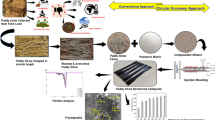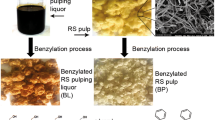Abstract
Over the recent years, two environmental issues have gained much attention — pollution caused by single use plastics and pollution caused by disposal of agricultural residues in inappropriate ways like stubble burning. Consequently, scientists have been trying to develop materials to replace single use plastics as well as eco-friendly techniques for disposal and valorization of agricultural residues.
The present study was planned to explore its utilisation for developing a compostable bio-polymer with polylactic acid (PLA) matrix and paddy straw powder (PSP) as a bio-filler. To enhance its ready degradation, paddy straw was pre-treated with NaOH before extrusion into granules. The composite granules were produced using a melt-mixing method, and their structure and morphology were analysed using scanning electron microscopy. Incorporation of paddy straw led to changes in the microstructure of the composites, and a homogeneous distribution of paddy straw fibres in the samples was observed. Furthermore, the nucleation effect in developed composite materials was confirmed by X-ray diffraction (XRD) and Fourier transform infrared (FTIR) analysis. Each PLA-PSP composite exhibited variation in physical, morphological, thermal, and mechanical characteristics. Thermal degradation temperature of the composite material increased by more than 58°C with increased concentration of PSP. While considering all the parameters, composite material with 30% PSP concentration exhibited the most desirable characteristics in terms of balance of strength, thermal stability, and surface properties material. The PLA-30%PSP composite material had a browning index of 39.04±1.69, degradation temperature of 382.70 °C, glass transition temperature of 76.39°C and impact strength of 62.37 ± 5.63 J/m. This study provides an insight into development of structure of PLA-paddy straw fibre composites and their characterisation for potential application as eco-friendly, compostable alternative for food packaging.








Similar content being viewed by others
Data availability
The data that support the findings of this study are available from the corresponding author upon reasonable request.
References
Silva-Cavalcanti JS, Silva JDB, de França EJ et al (2017) Microplastics ingestion by a common tropical freshwater fishing resource. Environ Pollut 221:218–226. https://doi.org/10.1016/j.envpol.2016.11.068
Zhu Y, Romain C, Williams CK (2016) Sustainable polymers from renewable resources. Nature 540:354–362
Shimao M (2001) Biodegradation of plastics. Curr Opin Biotechnol 12:242–247
Vink ETH, Rábago KR, Glassner DA et al (2004) The sustainability of NatureWorksTM polylactide polymers and IngeoTM polylactide fibers: an update of the future. Macromol Biosci 4:551–564. https://doi.org/10.1002/mabi.200400023
Lunt J (1998) Large-scale production, properties and commercial applications of poly lactic acid polymers. Polym Degrad Stab 59:145–152. https://doi.org/10.1016/s0141-3910(97)00148-1
Gupta B, Revagade N, Hilborn J (2007) Poly(lactic acid) fiber: an overview. Prog Polym Sci 32:455–482
Smoca A (2020) Ftir spectroscopy analysis of pla biocomposites reinforced with hemp fibers. Key Eng Mater 850:112–117. https://doi.org/10.4028/WWW.SCIENTIFIC.NET/KEM.850.112
Lee BK, Yun Y, Park K (2016) PLA micro- and nano-particles. Adv Drug Deliv Rev 107:176–191
Murariu M, Dubois P (2016) PLA composites: from production to properties. Adv Drug Deliv Rev 107:17–46
Gui ZY, Wang HR, Gao Y et al (2012) Morphology and melt rheology of biodegradable poly(lactic acid)/poly(butylene succinate adipate) blends: effect of blend compositions. Iran Polym J (English Ed) 21:81–89. https://doi.org/10.1007/s13726-011-0009-7
Fambri L, Pegoretti A, Fenner R et al (1997) Biodegradable fibres of poly(L-lactic acid) produced by melt spinning. Polymer (Guildf) 38:79–85. https://doi.org/10.1016/S0032-3861(96)00486-7
Farah S, Anderson DG, Langer R (2016) Physical and mechanical properties of PLA, and their functions in widespread applications — a comprehensive review. Adv Drug Deliv Rev 107:367–392. https://doi.org/10.1016/j.addr.2016.06.012
Pongputthipat W, Ruksakulpiwat Y, Chumsamrong P (2022) Development of biodegradable biocomposite films from poly(lactic acid), natural rubber and rice straw. Polym Bull 80:10289–10307. https://doi.org/10.1007/S00289-022-04560-0/METRICS
Saidi MA, Gorin A, Soon KH, Jayamani E (2018) The optimum sodium hydroxide concentration for high strength pla-rice straw composites. J Mech Eng Sci 12:3472–3478. https://doi.org/10.15282/jmes.12.1.2018.14.0308
Agirgan M, Agirgan AO, Taskin V (2022) Investigation of thermal conductivity and sound absorption properties of rice straw fiber/polylactic acid biocomposite Material. J Nat Fibers 19:15071–15084. https://doi.org/10.1080/15440478.2022.2070323
Torres J, Cotelo J, Karl J, Gordon AP (2015) Mechanical property optimization of FDM PLA in shear with multiple objectives. JOM 67:1183–1193. https://doi.org/10.1007/s11837-015-1367-y
Wach RA, Wolszczak P, Adamus-Wlodarczyk A (2018) Enhancement of mechanical properties of FDM-PLA parts via thermal annealing. Macromol Mater Eng 303. https://doi.org/10.1002/mame.201800169
Rasselet D, Caro-Bretelle AS, Taguet A, Lopez-Cuesta JM (2019) Reactive compatibilization of PLA/PA11 blends and their application in additive manufacturing. Materials (Basel) 12. https://doi.org/10.3390/ma12030485
Xu Z, Yang L, Ni Q et al (2019) Fabrication of high-performance green hemp/polylactic acid fibre composites. J Eng Fiber Fabr 14. https://doi.org/10.1177/1558925019834497
Popy RS, Nayeem J, Arafat KMY et al (2020) Mild potassium hydroxide pulping of straw. Curr Res Green Sustain Chem 3:100015. https://doi.org/10.1016/j.crgsc.2020.100015
Redl A, Morel MH, Bonicel J et al (1999) Rheological properties of gluten plasticized with glycerol: dependence on temperature, glycerol content and mixing conditions. Rheol Acta 38:311–320. https://doi.org/10.1007/S003970050183/METRICS
Domenech T, Peuvrel-Disdier E, Vergnes B (2013) The importance of specific mechanical energy during twin screw extrusion of organoclay based polypropylene nanocomposites. Compos Sci Technol 75:7–14. https://doi.org/10.1016/J.COMPSCITECH.2012.11.016
Zalpouri R, Kaur P, Kaur A (2020) Influence of developed refractance based drying method on physical parameter of potato flakes. Int J Chem Stud 8:2833–2838. https://doi.org/10.22271/CHEMI.2020.V8.I3AO.9645
Shomodder A, Thammawong M, Imaizumi T et al (2023) Existence of circadian rhythm and its response behavior under different storage conditions of soybean sprouts. J Plant Physiol 281. https://doi.org/10.1016/J.JPLPH.2022.153906
Suyambulingam I, Divakaran D, Siengchin S (2023) Comprehensive characterization of novel Borassus flabellifer flower biomass based microcrystalline cellulose reinforced with polylactic acid (PLA) biofilm for futuristic applications. Biomass Convers Biorefinery. https://doi.org/10.1007/S13399-023-04030-1
Yaacob ND, Ismail H, Ting SS (2016) Soil burial of polylactic acid/paddy straw powder biocomposite. BioResources 11:1255–1269. https://doi.org/10.15376/biores.11.1.1255-1269
Hajare B, Patil O, Barpande GS et al (2022) Tensile, impact and thermal properties of farm-waste based hybrid basalt polymer composites. Clean Mater 6. https://doi.org/10.1016/J.CLEMA.2022.100157
Popa CF, Krausz T, Galatanu SV et al (2022) Numerical and experimental study for FDM printed specimens from PLA under IZOD impact tests. Mater Today Proc. https://doi.org/10.1016/J.MATPR.2022.11.501
Bakshi MPS, Wadhwa M (2021) Paddy straw pelletization with other feedstuffs and its in vitro evaluation as livestock feed. Anim Nutr Feed Technol 21:595–604. https://doi.org/10.5958/0974-181X.2021.00050.0
Todo M, Takayam T (2011) Fracture mechanisms of biodegradable PLA and PLA/PCL blends. Biomater - Phys Chem. https://doi.org/10.5772/24199
Zhong J, Li H, Yu J, Tan T (2011) Effects of natural fiber surface modification on mechanical properties of poly(lactic acid) (PLA)/sweet sorghum fiber composites. Polym - Plast Technol Eng 50:1583–1589. https://doi.org/10.1080/03602559.2011.557817
Qi Z, Wang B, Sun C et al (2022) Comparison of properties of poly(lactic acid) composites prepared from different components of corn straw fiber. Int J Mol Sci 23. https://doi.org/10.3390/ijms23126746
Singh P, Kaur G, Singh A, Kaur P (2023) Starch based bio-nanocomposite films reinforced with montmorillonite and lemongrass oil nanoemulsion: development, characterization and biodegradability. J Food Meas Charact 17:527–545. https://doi.org/10.1007/S11694-022-01635-4
Aup-Ngoen K, Noipitak M (2020) Effect of carbon-rich biochar on mechanical properties of PLA-biochar composites. Sustain Chem Pharm 15:100204. https://doi.org/10.1016/J.SCP.2019.100204
Nayak SK (2010) Biodegradable PBAT/starch nanocomposites. Polym - Plast Technol Eng 49:1406–1418. https://doi.org/10.1080/03602559.2010.496397
Liuzzi S, Rigante S, Ruggiero F, Stefanizzi P (2016) Straw based materials for building retrofitting and energy efficiency. Key Eng Mater 678:50–63. https://doi.org/10.4028/WWW.SCIENTIFIC.NET/KEM.678.50
Singh VK, Chauhan S, Gope PC, Chaudhary AK (2015) Enhancement of Wettability of Aluminum Based Silicon Carbide Reinforced Particulate Metal Matrix Composite. High Temp Mater Process 34:163–170. https://doi.org/10.1515/htmp-2014-0043
Chen X, Yu J, Zhang Z, Lu C (2011) Study on structure and thermal stability properties of cellulose fibers from rice straw. Carbohydr Polym 85:245–250. https://doi.org/10.1016/J.CARBPOL.2011.02.022
Acknowledgements
The authors gratefully acknowledge the support provided by the labs in Department of Processing and Food Engineering, P.A.U., Ludhiana. Also, authors are thankful to the Vee Kay Polymers, Pune, India, for assistance in the extrusion process.
Funding
Financial support was provided in the form of senior research fellowship by the Indian Council of Medical Research (ICMR), New Delhi, India.
Author information
Authors and Affiliations
Contributions
Pratik Pandit Potdar: investigation: formal analysis; writing — review and editing; writing — original draft; data curation. Preetinder Kaur: conceptualization; funding acquisition; supervision; project administration; writing— review and editing. S. Radhakrishnan: conceptualization; methodology; visualization; Manpreet Singh: supervision; project administration. Himangi Neve: help in equipment handling, conceptualization. Sukhmeet Singh: conceptualization
Corresponding authors
Ethics declarations
Ethical approval
No ethical clearance is required. We declare that there are no animal studies or human participation involved in the study.
Conflict of interest
The authors declare no competing interest
Additional information
Publisher’s Note
Springer Nature remains neutral with regard to jurisdictional claims in published maps and institutional affiliations.
Rights and permissions
Springer Nature or its licensor (e.g. a society or other partner) holds exclusive rights to this article under a publishing agreement with the author(s) or other rightsholder(s); author self-archiving of the accepted manuscript version of this article is solely governed by the terms of such publishing agreement and applicable law.
About this article
Cite this article
Potdar, P.P., Kaur, P., Radhakrishnan, S. et al. Valorization of paddy straw through development of PLA-paddy straw fibre reinforced composites and their physical, morphological, mechanical and thermal characterization. Biomass Conv. Bioref. (2023). https://doi.org/10.1007/s13399-023-04752-2
Received:
Revised:
Accepted:
Published:
DOI: https://doi.org/10.1007/s13399-023-04752-2




